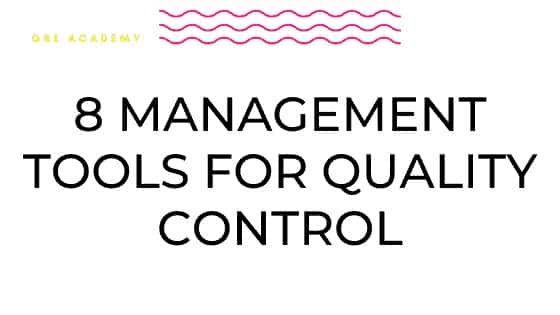8 Management Tools for Quality Control
Tools Quality Control
Quality control is an important process in a system of production that aims to make sure the delivered products meet the quality and performance standards as specified by the customer. Among others, Quality quality control indicators can be categorized into:
1) Process indicators (lead time, employee productivity, etc.) and
2) Product or service indicators (completion of process requirements have been met).
Quality Control seeks to minimize any variability in these indicators either within a process or between processes when many teams are involved spanning across multiple projects. This is done primarily through a focus on four key elements: communication, training, continual improvement, and problem-solving.
The 8 Management Tools for Quality Control
1. Flowchart: flowcharts are a static representation of a process. While flowcharts are useful for documenting the process, they do not provide a detailed view of the process’s efficiency (or inefficiency).
Use case example: documenting quality at the product stage
2. Pareto Diagram: a graphical representation of the data that can be used to identify 80% (or more) of the problem areas in a process. The Pareto diagram highlights the many criteria involved with determining process improvement areas.
Use case example: documenting quality at the process stage
3. Gantt Chart: visual support for scheduling activities in a specific time frame, where tasks are color-coded on a single chart according to their progress and run from top to bottom or left to right on individual charts.
Use case example: documenting quality at a process stage
4. Control Chart: a great tool for monitoring and managing changes in processes over time. This method allows you to see whether the process is improving overtime or not. The control charts can be used to ensure stability in the process, which can then lead to improved quality.
Use case example: documenting quality at an individual project stage
5. Histogram: a graphic representation of the data that can be used to identify patterns in data.
Use case example: improving quality at the process stage
6. Scatter Diagram: a graphic representation of the data that can be used to identify correlations in data.
Use case example: improving quality at the process stage
7. Pert Chart: a tool for understanding the relationship between related events, activities, or decisions. The PERT chart is most effective when there are clear and concise connections between related activities and is best used when uncertainty exists about time estimates.
Use case example: improving quality at the project stage
8. Kano Method: this process improvement method combines and collaboration of all previously mentioned techniques into one task, while also determining where improvements are really needed.
Use case example: improving quality at the project stage
When determining where to make improvements in a process, it is important to understand which areas “must not change”.
The most important quality control tools are those which interact with the customer and are used to improve the processes.
For example, a customer may complain that certain components were not delivered on time and that they should not have been shipped so late. The producer may then collect information (e.g., by interviewing or visiting a client) about this complaint in order to determine what caused the issue and how it can be avoided in the future.
Conclusion: Although the idea of quality control has been around for a long time, the modern approach has become more complex with the advent of many different tools that help managers not only keep track of their projects’ performance but also identify areas of improvement. A full understanding and use of these tools for quality control is essential for continued success in today’s world.
Looking for More Resources on ISO 9001?
If you found this article helpful, explore our premium resources designed to help you achieve ISO 9001 certification efficiently:
- 📦 Complete Documentation Package for ISO/IEC 9001 2015: Get all the essential templates and documents you need for fast, easy implementation.
- 🎓 Online Course on ISO/IEC 9001 2015 : Enroll in our comprehensive training to master the key concepts and practical steps toward certification.
- 📋 ISO/IEC 9001 2015 Checklist: Download our detailed checklist to ensure you’ve covered every step of the process.
These resources are tailored to meet your needs and ensure a smooth certification journey. Explore them today and get one step closer to success!

















